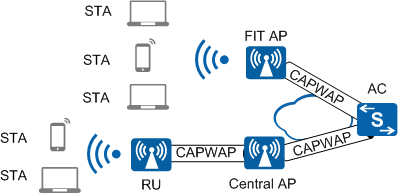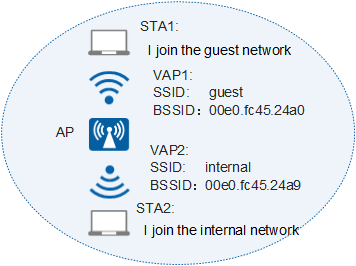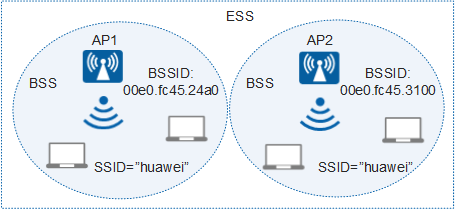Concepts Related to WLAN
Station (STA): a terminal that supports 802.11 standards. For example, a PC that has a wireless network interface card (NIC) or a mobile phone that supports WLAN, as shown in Figure 1.
Access controller (AC): a device that controls and manages all of the access points (APs) on a WLAN in the centralized architecture. For example, an AC can connect to an authentication server to authenticate STAs, as shown in Figure 1.
Access point (AP): a device that provides 802.11-compliant wireless access for STAs. APs connect wired networks to wireless networks.
- Fit AP: an AP that provides wireless access for STAs in the Fit AP architecture. A Fit AP provides only reliable, high-performance wireless connections and depends on an AC to provide other functions, as shown in Figure 1.
Central AP: an AP that takes over some of an AC's work in the agile distributed architecture to perform central management and collaboration of remote units (RUs), such as STA going online, configuration delivery, and STA roaming between RUs.
- Remote unit (RU): a remote radio module for a central AP in the agile distributed architecture. An RU receives and sends 802.11 packets through the air interface, as shown in Figure 1.
Radio signal: a high-frequency electromagnetic wave that has long-distance transmission capabilities. Radio signals provide transmission media for 802.11-compliant WLANs. Radio signals described in this document are electromagnetic waves in the 2.4 GHz or 5 GHz frequency band.
Control And Provisioning of Wireless Access Points (CAPWAP): an encapsulation and transmission mechanism. CAPWAP implements communication between APs and ACs, as shown in Figure 1.
- Virtual access point (VAP): a WLAN service entity on an AP. You can create different VAPs on an AP to provide wireless access service for different user groups.
Service set identifier (SSID): a unique identifier that identifies a wireless network. When you search for available wireless networks on your laptop, SSIDs are displayed to identify the available wireless networks.
SSIDs are classified into two types:- Basic service set identifier (BSSID): the link-layer MAC address of a VAP on an AP. Figure 2 shows the relationship between VAP and BSSID.
- Extended service set identifier (ESSID): a chosen identifier for one or a group of wireless networks. For example, in Figure 2, SSID guest identifies one wireless network, and SSID internal identifies another wireless network. A STA scans all wireless networks and selects a wireless network based on the SSID. In general terms, an SSID refers to an ESSID.

Multiple APs can use one ESSID to provide roaming service for users; however, their BSSIDs must be unique because the MAC address of each AP is unique.
Basic service set (BSS): an area covered by an AP. STAs in a BSS can communicate with each other.
Extend service set (ESS): a group of BSSs that share the same SSID.
Figure 3 shows the relationship between SSID, BSSID, BSS, and ESS.


